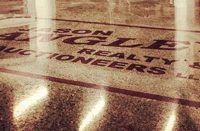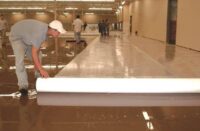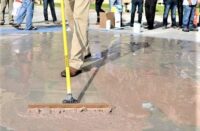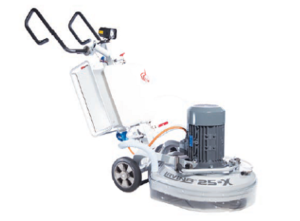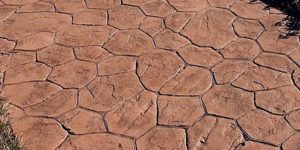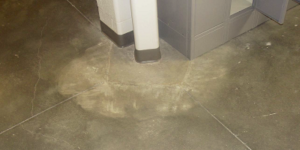Tip one: Play sand can be a contractor’s best friend when it comes to concrete grinding and polishing.
Play sand is a great thing to keep handy as an abrasion aid when using a concrete grinder. It keeps the diamonds dressed and cooled while acting as a secondary abrasive to assist in the actual grinding process.
For example, say a contractor is making the first cut to prep a concrete surface. If, after the first 200 feet, he notices that his tools are no longer cutting and producing debris, he can simply throw down some play sand. Likely, the problem is that the tools have heated up and the matrix has started to swell, trapping diamonds and refusing to release them so that the next diamonds can cut. The play sand will provide the necessary debris to help the tools abrade away some of the matrix and expose the new diamonds.
The end result: Constantly dressed tools for maximum performance.
In addition, play sand keeps the sealer, adhesive, mastic, etc. from collecting back together to form a mass, which can smear back to the substrate during the progress.
Tip two: Rotating concrete grinding machines can extend the life of diamond tooling.
Rotating a machine can help a contractor in many ways. For those new to the business, this can usually be easily accomplished by finding and activating the “rotation” button on the grinder. Doing this will redress a diamond that has a direct wear pattern and will help open a glazed tool. Rotating your machine will also help cool stones, producing a different leading edge.
If you are grinding soft, porous concrete, rotating your machine will help as well. For example, some soft concrete will wear the leading edge of the tool segment, changing the surface of the tool. With the surface area changed, the tool can leave behind erratic scratches and a very inconsistent appearance on the surface. This could reflect through a thin-mil covering and get a polish job off to a bad start.
Tip three: Presoaking carpet adhesive is a good idea when it comes to removal.
Yellow and white adhesive is almost always water-based. By presoaking it, you will rehydrate the adhesive to create swelling in the material.
As the material swells, it can “debond” itself from the concrete, making it much easier to remove. You should note that this is not a full wet grind or scrape, and you should only use enough water to soak in and rehydrate. If too much water is used, the material will spread on the surface and dry, resulting in the same type of removal issue as before. Use just enough water to gather the material in small chunks after scraping.
Presoaking will also help keep the temperature of the tools down, reducing smearing.
Some carpet adhesives can have a green or blue color. These adhesives are most likely epoxy- or urethane-based. Water will not help with that type of removal, but play sand will.
Tip four: Presoaking a very hard-trowel slab can make the grind a little easier.
Contractors can presoak a hard-trowel slab to aid grinding. This will help reduce the surface tension of the slab and flush small aggregate and sand to the surface.
The aggregate and sand will aid the opening steps of your grind. They act as a secondary abrasive and will assist in the abrasion of the diamond matrix to produce fresh diamonds in the tool.
Presoaking will also bring the surface temperature of the concrete down, helping with operational temperatures of the tooling.
Sometimes what appears to be a hard-troweled slab is really a tight slab with thin layers of cure-and-seal. This type of sealer can glaze a tool, causing it to heat up. The sealer can be removed with play sand and water.
Tip five: It is very important to keep the water channels open on wet resin pads and wet-transfer tooling when wet grinding.
When wet-cutting with a transition tool or resin, it is critical to make sure that the water or air channels stay open.
If they get clogged, they could trap spent tools in the built-up slurry paste and produce an irregular, unwanted scratch. Open water channels give the slurry a place to escape, leaving a clear path for debris that follows.
Keeping the channels open ensures the tool maintains a proper operating temperature. Even though the tool is operating in a wet condition, the building of debris in the water channel can affect the temperature, resulting in premature wear or improper performance.
If a large project is being performed, make sure the second shift understands the amount of water needed to perform at peak levels. Contractors should make sure that the first-shift crew relays the proper information to the second shift, so that the end result of the job is consistent throughout.
And by the way, never run a dry-only pad wet!
